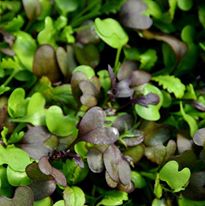Microgreen Mix – Hot & Spicy
€2.95
Description
Microgreen Mix – Hot & Spicy is a mix of delicious varieties of salads and herbs suitable for eating as baby leaves.
What are microgreens or microsalads?
Microgreens (also known as micro leaves, micro salads) are becoming very popular in restaurants as well as finding their way into supermarkets (pre-packed). A few years ago only few people have heard of them but now they are the big new fad in the gardening and cooking world.
Microgreens are seedlings which are harvested before they grow into larger plants. In fact the seeds used to grow microgreens are the same as for full sized vegetables, salads and herbs.
Examples include: All oriental salads (rocket, mizuna, mustards etc), lettuce, leaf beet, beetroot, orach, amaranth, dill, coriander, chervil, perilla, basil, Brassicas (kale, cabbage, cauliflower, radish, kohlrabi etc), carrots, peas, parsley and many more.
Gardening with children:
Microgreens are really one of the easiest salads to grow and make an ideal starter crop for children. You can be inventive and find recycled sowing containers (with a minimum depth of 5cm) such as small mushroom or tomato punnets painted yoghurt pots or eggshells. All you need to do is to puncture a few holes in the bottom and sit it in a tray or saucer so the water won’t leak out onto your windowsill.
Grow your own microgreens:
Microgreens are very expensive if you buy them in shops in shops but luckily anyone can grow them very easily. You don’t even need a garden – a south-facing windowsill will do. From spring onwards you can grow them outdoors in pots or a weed free seedbed in the garden.
Indoor growing:
You’ll need:
– a sunny windowsill,
– a shallow tray with drainage holes
– seed compost
– micro green seeds.
As seed compost I generally use either the Klassmann Organic seed compost (from Fruit Hill Farm in Co. Cork) or the ‘Living Green’ vermicompost from Co. Donegal. Both of them are excellent for this purpose and are available in good garden centres. But if you don’t manage to get hold of them any other brand would do. Home-made compost is not suitable for this purpose because of the weed seeds that are in it.
Instructions:
Overfill a seed tray with the compost and cut away the excess compost with a board to leave it level. After that press down the compost with a homemade board that fits exactly into the tray. Then sprinkle the seeds quite thickly onto the level compost (about 0.5cm apart) using your thumb and forefinger.
Once the seeds are scattered sprinkle some seed compost over the seeds to cover them lightly (about 0.5cm deep). When finished gently water the tray and place onto a south facing windowsill keeping the compost moist (not wet or dry) at all times. No additional feed is required.
Outdoor sowing:
From about mid April onwards you can grow microgreens outdoors. Ideal containers include idle window boxes or hanging baskets. It will put them to good use before you plant your summer flowers.
You can also sow the seeds directly into your garden bed. This is more difficult though because you may get a lot of weed seeds growing through your crop and definitely not all of them are edible.
Some weeds such as groundsel can actually be quite harmful. So if you sow directly into your vegetable garden I recommend the following:
Make a shallow trench about 10cm wide and 5 cm deep. The next trench can be 10cm away from the first one. Then backfill the trench with a weed free seed or multi-purpose compost.
Scatter the seeds thickly (about 0.5cm apart each way) onto the composted area.
Cover the seeds lightly with more seed compost and water in gently.
The warmer your soil the quicker they will germinate. After about 3-4 weeks after sowing they are ready to harvest.
Harvesting Microgreen Mix – Hot & Spicy
Here is the fun part. Microgreens can be harvested about 2 -3 weeks after sowing the seeds. Simply cut the seedlings as low as possible with sharp scissors and use as required. Please note that they will not re-grow like the popular cut-and-come-again salads. The reason for that is that the growth point of a plant is above the first seed leaves (cotyledon) and once that is cut off the plant cannot re-generate.
So only harvest as much as you need because once cut the leaves will lose their vitality and goodness. Remember “Fresh is best”.
A little bit of botany may be interesting here:
A seed needs to absorb moisture through its seed coat, then the first root called ‘radicle’ emerges and connects the plant with the earth. The next step is the shoot made up of the hypocotyl (the stem) and the cotyledons (seed leaves). Some plants have two cotyledons (dicotyledons) and some have only one cotyledon (monocotyledons). Monocotyledons include grasses and members of the Allium family (leeks, onions, chives and garlic). All of the microgreens are dicotyledons with 2 seed leaves. The interesting fact is that the seed leaves were already in miniature form in the seed and are pushed up towards the light to make the first food for the plants. Soon after the first true leaves start to emerge and this is the stage when you can start harvesting your micro leaves.
Definition of microgreens:
Microgreens are seedlings which have a central stem which is cut just above the soil level. It has two fully developed seed leaves as well as one pair of partially developed first true leaves.
Uses of microgreens:
Microgreen Mix – Hot & Spicy are ideal for garnishing a special dish and also make ideal salad ingredients or could comprise a salad in itself. A few micro leaves will cheer up any sandwich. Some people use them in stir-fries and in soups. I personally think they are a bit wasted for that purpose. However, if you have a glut it’s a good idea to use them up. I have also heard that they are used in smoothies and even in cocktails or desserts.
Each type has a unique flavour, colour and shape. Depending on the variety the flavours range from spicy, peppery, ‘cabbagey’, as well as aniseed flavours from chervil and the unique coriander and dill flavours. The colours range from light to dark green, yellow, orange, pink (from the rainbow chard) to red, bronze and purple from various mustards.
No wonder they have become so popular.
Are Microgreens the same as Sprouting Seeds ?
Microgreens are quite distinct from Sprouting Seeds as they are generally grown in a soil/compost medium and in natural sunlight.
Sprouting seeds are simply seeds that have germinated in the dark in quite an artificial surrounding. The seed, root, stem and the pale seed leaves are consumed. As microgreens grow in full sunlight they develop their true colour and only the stem and leaves are eaten.
As mentioned earlier sprouting seeds are not grown in a compost. The seeds are not planted, but placed in enclosed containers and rinsed regularly. They are ready to be consumed with a few days of sowing.
Microgreen Mix – Hot & Spicy
Are Microgreens healthier?
All vegetables are healthy, in fact the more the better. But are Micro Greens healthier than fully mature vegetables? Well if you browse the website you’ll find lots of information on the health benefits of micro greens – some even claiming it as the new miracle food. The downside of that is that there is no scientific evidence to support any of these claims to date.
The main reason why I love them is that they are so easy to grow, children love growing them, they taste delicious and they look fabulous and cheer up any meal.
Would you like to subscribe to my monthly gardening newsletter?
https://greenvegetableseeds.com/newsletters/
The Irish Garden magazine:
https://www.garden.ie/the-irish-garden-magazine/




